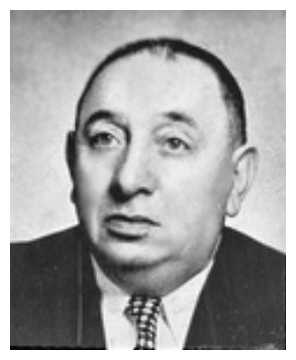
Dovid Koniecpoler
|
by Dovid Koniecpoler

Dovid Koniecpoler |
By the end of the 19th and the beginning of the 20th century, Jewish Radomsk totaled almost eight thousand souls. Thanks to the industrial enterprises where several thousand Polish workers were employed, the Jewish storekeepers and craftsmen were able to earn their wages. They also served thousands of Hasidim traveling to the rebbes, during the year and particularly during the Days of Awe. There were also several bigger wholesale businesses that served the poorer, smaller villages and shtetlech.
With the natural increase in the number of workers, the above mentioned jobs were not enough for all, and many searched for help in emigration. At the end of the 19th century, a small group of Nowo-Radomsker Jews was already found among the large number of the estranged in New York, with a great longing for their old home city.
On the 6th of February 1898, the founding meeting of the group of landsleit (countrymen) took place in the apartment of Shlomoh Zilberszatz (Samuel Silverschatz*) with the participation of Mordekhai Grosberg (Morris Grossberg), Yakob-Yosef Litman (Jacob J. Litman), Yakob Bursztein (Jacob Burstein), Neiman Eikhner (Nathan Eichner), Sam Litman, Moishe Neisztadt (Morris Neistadt), Heiman Rotsztein (Hyman Rothstein), H. Fein (Pine), M. Beser (Besser), Abe Kurcz (Kurtz), Moricz Granek (Morris Granick), Sam Tyl (Teil), M. Winer (Weiner), Y. Cymberg (I. Cymberg), Chaim Watrowski (Hyman Viatrofsky) and Sam Kurcz (Kurtz). It was then decided to establish the Nowo-Radomsker Sick Benefit Organization. Every Radomsker landsman (and landsman from towns in the vicinity) could join the organization with the payment of dues of one dollar. By the second meeting additional landsleit became members, and likewise at all subsequent meetings.
(Translator’s note: The anglicized spellings are taken from "The Nowo-Radomsker Almanac, 1899-1939 Jubilee Edition.")
The first request to the organization for support came from the Częstochower* Hachen Soifer, and it received the requested two-dollar benefit.
(Translator’s note: This transliteration of the Yiddish spelling of the city of Częstochowa is being used to reflect the Yiddish pronunciation.)
At the third meeting (the 27th of February 1898), it was decided to engage a doctor for the organization to provide medical help for the members.
Because of the small number of Nowo-Radomskers in New York, it was decided to accept members from other cities in Poland. On the 21st of May 1901, the organization had 46 members.
After the first three years of the existence of the organization, it was decided to expand the activities in several directions. It was decided with the payment of yearly dues, to join with the Austrian Hebrew Charity Association, which had a medical center for poor sick Jews (Dr. Sendelman was elected as delegate).
In 1902-1905 the membership of the organization grew, and it expanded its activities to include meeting with other landsmanshaftn and their institutions. There was support for several friendly organizations and successful theater benefits were held, which brought in significant amounts of money. Many members of the organization were already American citizens, and this had a marked effect on the organization in general.
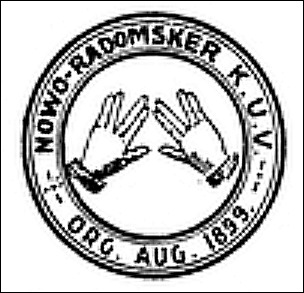
The emblem of the Society |
Assistance for needy members was widely expanded. The organization tried to
provide help to every needy member in every form. In general the members were
like one friendly family. When someone had a happy occasion, everyone rejoiced;
and when, G-d forbid, there was bad luck, everyone shared in the grief. The landsmanshaft
was literally an island of intimate familiar friends in greater New York, who
cared for the needy in every place and contingency.
The events in the old home, in the greater Russian Empire in general and
particularly in Poland, naturally had a strong influence on the organization.
The Russo-Japanese War strongly affected emigration to America, including from
Nowo-Radomsk. When the large group of Jews came, they found an address to which
they could turn. Everything was done to facilitate arrangements for them based
on the opportunities then available.
[Page 500]
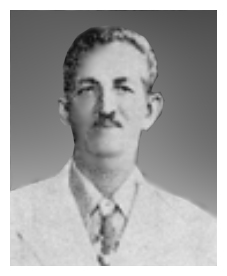 |
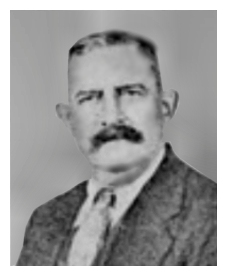 |
|
| Shlomoh (Sol) Greenberg (1905) | Aron Gliksman (1904) | |
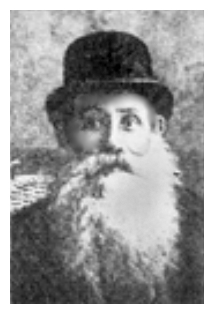 |
||
| Wolf Dikerman (1906) | ||
On the first of May 1906, a special committee was created with the charge of working out a plan for a ‘sick benefit.’ At that time, the organization possessed $578, and the establishment of a Help-Fund for needy members was proposed. A short time later it was decided that the ‘sick benefit’ should start to function in August 1906, and to that end each member was assessed one dollar.
Various landsmanshaftn (such as the Lodzers and others) created special aid committees to support the revolutionary movement in Poland. The Nowo-Radomsker organization supported all the committees with significant contributions and, in general, the organization helped every institution that solicited monetary help.
On the 3rd of September 1907, it was decided that the organization would assume a yearly assessment for the Hebrew Immigrant Society.
It was decided on the 18th of January 1908 that the Nowo-Radomsker organization would buy a cemetery (a plot for a besoylem [cemetery]) and a special committee was established to realize the project. On the 3rd of March 1908 the first death occurred, that of the wife of Brother Max Winer, and the organization participated in giving her last honors, with two groups as a proper delegation to the funeral.
On the 22nd of July 1908, it was decided to call a special meeting of women members to create a women’s organization. By the 18th of August 1908, the first delegates from the newly created women’s organization appeared at a general meeting and promised to help the men’s organization with its activities.
On the 4th of August 1908, a decision was made that the organization would join the newly established Association of Russian-Polish Jews, with yearly dues of $10 (Brothers M. Grosberg and D. Ziskind were elected as the delegates to the Association).
On the 2nd of November 1909, it was decided to support the Retail Dry Goods Clerks Union with a collection of money for their strike. The appeal of Reverend Tsvi-Hirsz Moslianski to support the Denver Sanitarium was accepted; it was decided to contribute $10 and to join the Sanitarium with a yearly contribution.
Assistance to members was expanded in 1910. Help was given in the amounts of $10, $15, $25 and in very special circumstances even $100. At that time, a larger strike by the garment workers occurred; the striking members of the organization were exempted from membership contributions.
A special Loan Fund was established in 1914, which gave every member the right
to a loan. The importance of the Loan Fund was that a member could obtain a
loan and pay it back according to his ability.
On the Threshold of the Twentieth Anniversary
When the First World War broke out, and a wall of fire and blood stood between the organization and the home city Nowo-Radomsk, the landsman trembled over the fate of those close to them. By November 1914, the Radomsker organization had already called a mass meeting at which they created a Relief Committee for the Jews in Radomsk. In the first years of the war every connection with Poland, in general, and Radomsk, in particular, was cut off, and the Committee reduced its activity. It was in March 1916 that a group of members (Sam Szmerling and Harry Gliksman at the head) first decided to send $200 to Radomsk. The sum was received by the leading warden of the synagogue of the community in Radomsk, Mr. Fiszel Dunski.
With this campaign the Nowo-Radomsker organization in New York concluded a
grand chapter in its activities of organizing mutual assistance for immigrants,
enabling them to acclimate themselves to the specific situation in America at
that time. The Radomsker Jew was accustomed to seeing himself as a member of
his city’s organized community, which had created – for better or worse
– necessary institutions such as synagogues, prayer and study houses,
cemeteries, etc. But in its new home in the great shmaltz-tup (‘land of plenty’)
that is called New York, the organization had to newly build and organize. The
Nowo-Radomsker organization strove with all its fervor to create and open a new
chapter in the history of its work.
[Page 501]
In 1917, the first news arrived about wounded Radomsker landsleit in
the American Army: Brothers Foirs, Grosberg, and Abraham Soberman and
later, Sam Gold and Max Goldberg. A committee of members B. Bialik, Sam
Szmerling and M. Goldberg maintained written connections with the wounded and
took care of all of their needs. In addition to the special Soldiers Fund for
this purpose, a fund of $500 was also created for later support for the wounded
Radomsker brothers after their return from the American Army.
The organization contributed (at the same time) $50 for the Jewish Welfare Fund and bought Liberty Bonds worth $400.
On the 7 th of December 1918, the organization decided – at the request of the People’s Relief Committee – to support all Jewish war victims, and $100 dollars was given for this purpose.
In April 1918, the Radomsker Ladies Society celebrated its 10th anniversary. Then news came from Poland, which was in the first honeymoon of its independence, of pogroms in several cities. Under the leadership of a specially created committee, the whole organization took part in a giant protest demonstration of American Jewry (the 21st of May 1919) and donated an appropriate monetary contribution.
Mendel Besser of blessed memory, the meritorious chairman of the Cemetery Committee, died in 1919, and Aron Gliksman was elected in his place. At that time the organization had sections of its own in two cemeteries: Mount Sinai (sic) with 8 plots and Mount Hebron with 16 plots. (Translator’s note: There is no Mount Sinai listed among the cemeteries in the New York metropolitan area; the Nowo-Radomsker Society does have a section in Mount Zion.)
On the 21st of December 1919, the 20th anniversary
of the organization was celebrated with a beautiful banquet. The organizing
committee of the banquet included as chairman, Chaim-Moishe Grosberg,
vice-chairman W. Witrofski and Secretary R. Kreitzberg. A whole row
of delegates from other landsmanshaftn greeted the organization, and
the intense activity of its meritorious members during the twenty years of its
existence was celebrated, especially that of Aron Gliksman.
All Aspects of Financial Support and Communal Activities
With the 20th anniversary of the Radomsker organization in New York, its structure, its direction and its objective were changed. Life itself and the bitter lot of those still in Radomsk had dictated this: that Jews who left Radomsk and settled down in America, the greatest and freest country, should take upon themselves the burden of helping their parents, brothers, sisters and, in general, the local Jewish population remaining in Radomsk.
On the 17th of February 1920, members Aron and Philip Gliksman proposed that the organization establish its own Relief Fund. A mass meeting of Radomsker landsleit in America was held on the 21st of February 1920 for this purpose, about which we read in ‘Almanac’ (Translator’s note: the program for the 40th anniversary banquet) the following:
‘This meeting will surely remain historic in the history of our relief activities. There was a mood of tension in the hall; everyone felt responsible for nothing having been done for our home city. The speakers who expressed themselves at the meeting took it upon themselves to create sympathy. Everyone was filled with the adesire to make good that which had been neglected until today.’
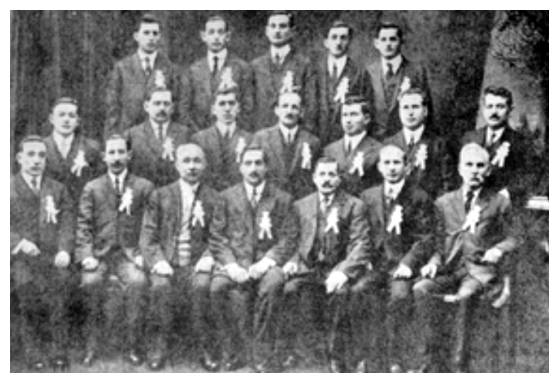 |
| The organizing committee in 1916 |
|
First row – Standing (from the right): M. Zilberman, Gold, M. Goldberg, A.
Z. Zoberman. S. Szlamkowicz
Second row: L. Weiskopf, M. Goldman, B. Szlamkowicz, A. Banas, Ch. Witrofski, Ch. Bandstein, F. Gliksman Sitting: J. Bergstein, Sz. Szmerling, Chaim-Moishe Grosberg, Antingos, M. Besser, Feiwlowicz, H. Gliksman |
At the meeting a sum of $132 was raised and a special committee was elected
under the chairmanship of Philip Brakhman and [with] Morris Schwartz as
secretary. The Committee was supposed to undertake a large relief campaign;
unfortunately, there was great disappointment when all calls for contributions
by the committee were as a ‘cry in the desert.’ Later, a younger group of
activists joined and the activities and support of the Relief Committee
increased. The group was made up of Paul Rubin, Morris Schwartz, Max Shapiro
and other members. The first collection brought in $150. Sol Greenberg donated
$50 and, on the 12th of March 1920, $200 was sent to Radomsk.
On the 4th of April 1920, at a special Relief meeting, the sum of $300
was raised, which was immediately sent to Radomsk. The same month $700 was
collected and quickly sent to Radomsk.
Elections to the Relief Committee were held on the 19th of June 1920, and Chaim-Moishe Grosberg, Paul Rubin and Morris Schwartz were elected.
On the 4th of February 1921, $300 was sent to Radomsk for Passover.
In addition, during the above mentioned months the organization created a
credit union, which began to function on the 16th of April 1921 with
the granting of interest-free loans to members.
[Page 502]
On the 4th of June 1921 the Relief Committee decided to establish
an interest-free loan office in Radomsk, and Brother Sol Greenberg committed
himself to doubling every contribution made for this purpose.
In 1920, the Zionist Revival Fund, Keren Ha-Yesod, was established. Members Harry Fishman, P. Gliksman and A. Feiwlowicz were delegated to represent the Radomsker organization at a conference of Keren Ha-Yesod called by the Federation of Polish Jews in America. The organization took a considerable part in the Keren Ha-Yesod campaign (the Radomsker Society donated at that time $1,234 to Keren Ha-Yesod), and thereby strengthened the National-Zionist consciousness of our landsleit in America.
At the end of January 1921, it was decided that the organization would support the activities of the composer Bensman, who earlier was the conductor and musical leader of the Hazomir (Choir) in Radomsk.
On the 21st of January 1922, it was decided to send $100 to the orphanage in Radomsk named for Dr. Mitlman. Simultaneously it was decided to support the HIAS (Hebrew Immigrant Aid Society) Campaign with $100, in faithfulness to the principle of the [Nowo-Radomsker] organization to participate with counsel and deed in every communal campaign of American Jewry. It was decided in March 1922 to support HIAS’s ‘$5,000,000 Campaign’ with another $200. At the same time, each member of the organization was assessed $3 for the Interest-Free Loan Office in Radomsk. On the 16th of September 1922, it was decided to send another $300 to Radomsk for interest-free loans. After that, the report that was received from Radomsk was full of optimism. The same month $50 was appropriated for the ‘People’s Relief.’
The Society carried on redoubled [and] vigorous internal activity besides the Credit-Union, Cemetery and other campaigns for assistance for individuals and the community at large; theater benefits and community entertainment events were very often arranged, which brought in significant income. This enabled the organization to take part in the various national, community and philanthropic campaigns of American Jewish institutions with greater material backing, together with wider backing for Radomsk.
On the 17th of February 1923, approval was given to send $200 for moes-khitim [to provide Passover needs to the poor] for Passover, and an additional $300 [was sent] with Brother Flakowicz, who was traveling to Radomsk for a visit. On the 25th of March 1923, at a ‘reception-meeting’ after his return from Radomsk, Member Flakowicz reported on the situation. He described the sad condition of the Jews in Radomsk and appealed for an increase of assistance for our brothers there. It was immediately decided to send $100 for furniture for the orphanage and a decision was made to undertake wider activity for further support of the city.
From the start of ‘Relief’ (March 1920) up to March 1924, a total of $2300 was
sent to Radomsk in addition to the private support that was encouraged by the
organization.
The 30th and 40th Anniversaries
After the First World War a very significant number of the young Jews in Radomsk emigrated, some to Eretz Yisroel and some to America. The latter were [readily absorbed by the organization] in New York through the [work of its] devoted community-minded workers.
In 1921 Yehezkel Rudnitsky [arrived in the United States]. Since 1926 he has been one of the active Society members, later the president of the organization.
Shlomoh Epsztein arrived in 1921. He immediately became an active and dear
worker for Radomsker ‘Relief’ in New York.
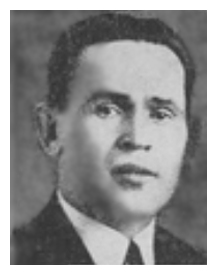 |
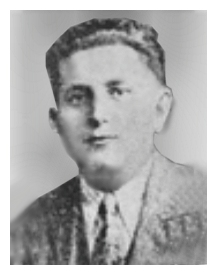 |
|
| Yehezkel Rudnitsky | (1921) | Shlomoh Epsztein |
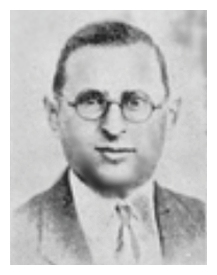 |
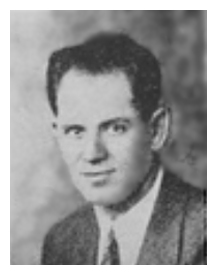 |
|
| Dovid Lewkowicz | (1923) | Shlomoh Epsztein |
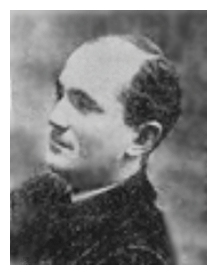 |
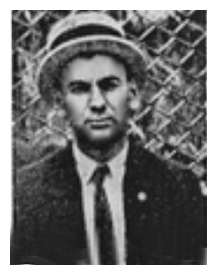 |
|
| Pinye Kalka (1925) | Fishel Gliksman (1924) |
|
JewishGen, Inc. makes no representations regarding the accuracy of
the translation. The reader may wish to refer to the original material
for verification.
JewishGen is not responsible for inaccuracies or omissions in the original work and cannot rewrite or edit the text to correct inaccuracies and/or omissions.
Our mission is to produce a translation of the original work and we cannot verify the accuracy of statements or alter facts cited.
 Radomsko, Poland
Radomsko, Poland
 Yizkor Book Project
Yizkor Book Project
 JewishGen Home Page
JewishGen Home Page
Copyright © 1999-2026 by JewishGen, Inc.
Updated 25 Sep 2022 by LA